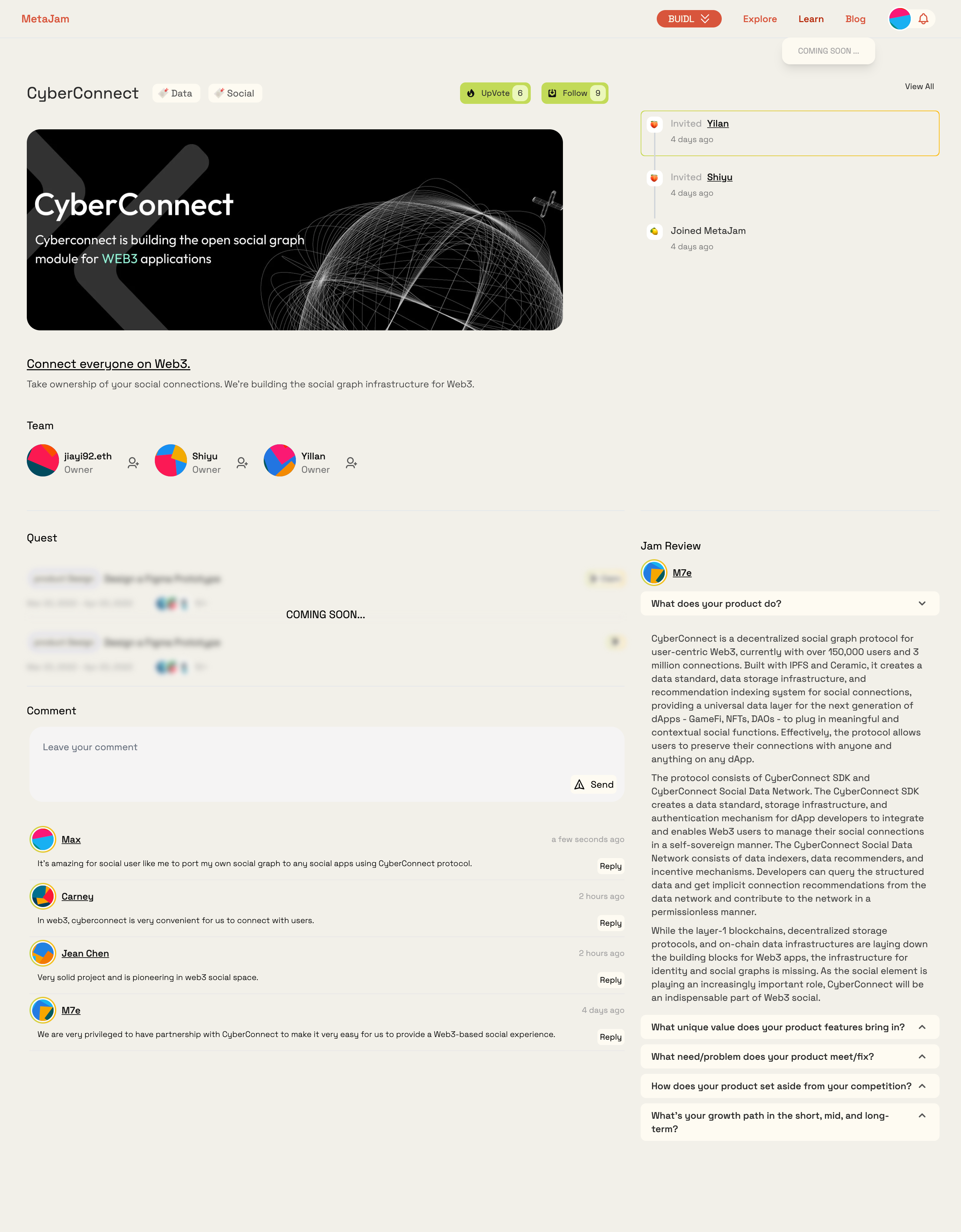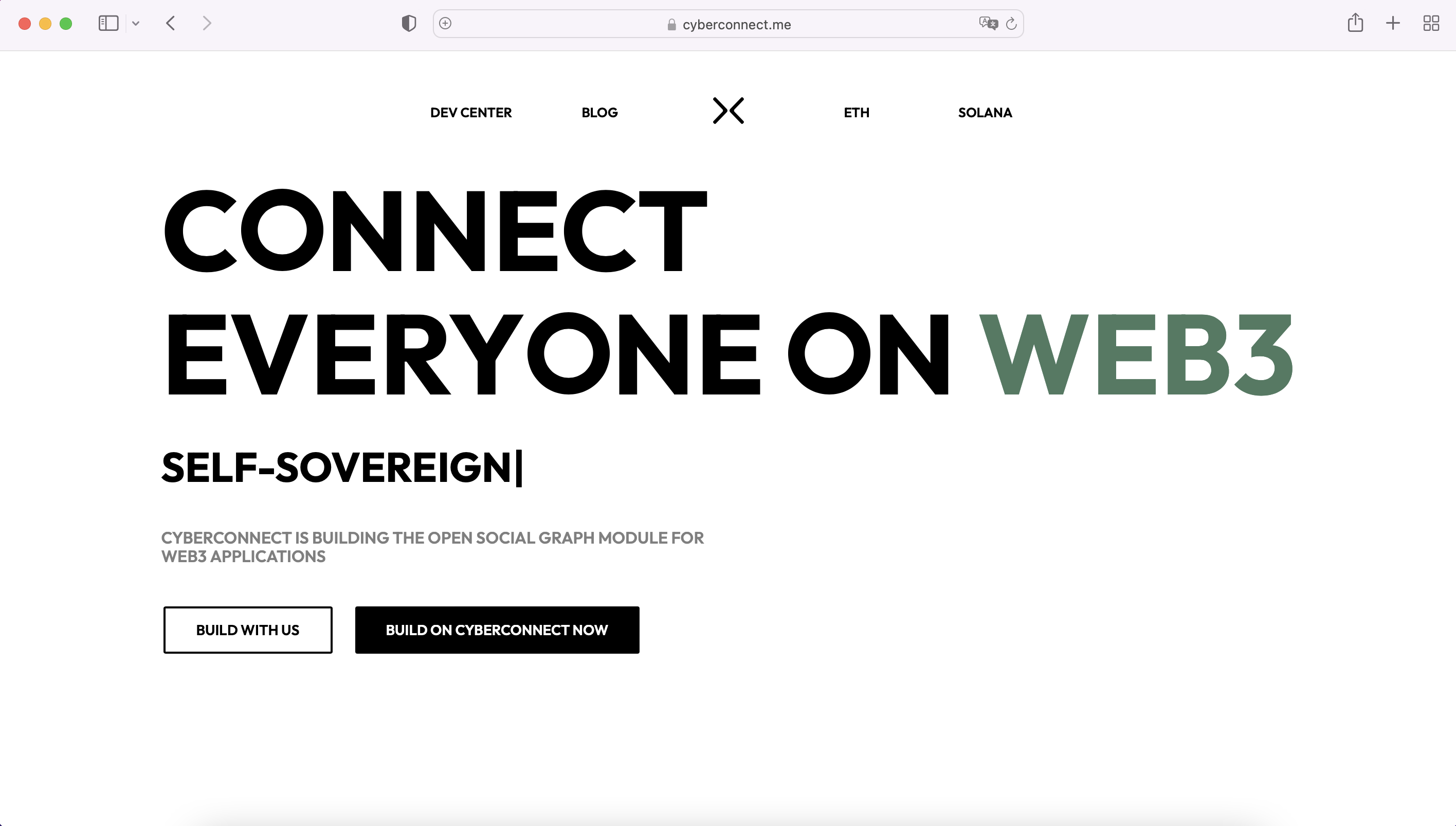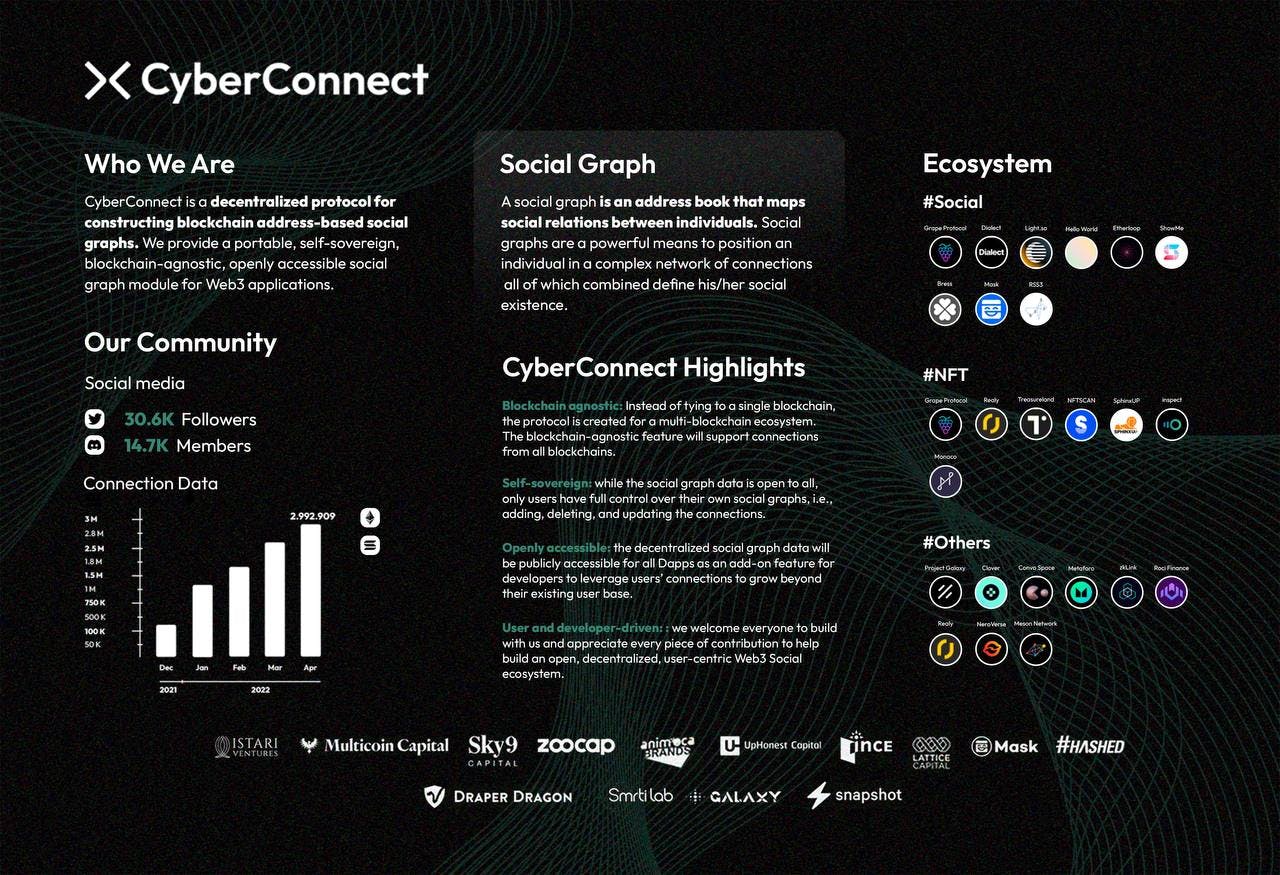Today Jam Review features CyberConnect, a decentralized social graph protocol for Web3. All dedicated Web3 BUIDLers are welcome to test and review this product and participate in helping the project grow from product, to recruitment, to community, to funding.
You can check out the CyberConnect project to experience MetaJam's Project Profile feature at https://www.metajam.studio/project/cyberconnect .

CyberConnect

-
Category: Social
-
Scouted by: M7e
-
Site:
-
Twitter:
-
Discord:
-
Blog:
https://mirror.xyz/cyberlab.eth
What does your product do?

CyberConnect is a decentralized social graph protocol for user-centric Web3, currently with over 150,000 users and 3 million connections. Built with IPFS and Ceramic, it creates a data standard, data storage infrastructure, and recommendation indexing system for social connections, providing a universal data layer for the next generation of dApps - GameFi, NFTs, DAOs - to plug in meaningful and contextual social functions. Effectively, the protocol allows users to preserve their connections with anyone and anything on any dApp.
The protocol consists of CyberConnect SDK and CyberConnect Social Data Network. The CyberConnect SDK creates a data standard, storage infrastructure, and authentication mechanism for dApp developers to integrate and enables Web3 users to manage their social connections in a self-sovereign manner. The CyberConnect Social Data Network consists of data indexers, data recommenders, and incentive mechanisms. Developers can query the structured data and get implicit connection recommendations from the data network and contribute to the network in a permissionless manner.
While the layer-1 blockchains, decentralized storage protocols, and on-chain data infrastructures are laying down the building blocks for Web3 apps, the infrastructure for identity and social graphs is missing. As the social element is playing an increasingly important role, CyberConnect will be an indispensable part of Web3 social.
What unique value does your product features bring in?
There are 4 key properties of the protocol.
- Self-Sovereign - We return the ownership and utilities of social graph data back to users. Only users should have autonomy over how, where, and for what their data is used.
- Portable - Interoperability is key to a truly open web. We empower everyone to travel between apps with their own social graph as part of their Web3 identity.
- Blockchain agnostic - Not tied to any single blockchain, the protocol is created for a multi-blockchain ecosystem.
- Composable - Developers can integrate with our social graph module easily with two lines of code. Fast-forward bootstrapping and build upon it with agility for quick iterations. All without the need for dedicated backend data servers. Build experiences, not walls.
Further, social connections aggregated to addresses lead to holistic digital identities. Together with our democratized indexing system, this gives connections a whole new multitude of meanings and brings out data value like never before.
What need/problem does your product meet/fix?
There are three critical issues with social graphs previously in Web2:
-
Tyranny of the Titans: Industry titans infringe on users’ sovereignty over their own social graph data to further corporate interests. Accountability is scarce given the scope of monopoly power. Users have to bear the whims of changing platform rules and risk getting de-platformed and their social assets taken away.
For this, we enable users to own their connections and social data and to take the data to whatever platforms they prefer. For example, an influencer will be able to take the follower base to any social media app.
-
Silos and Redundancy: Web2 social networks are walled gardens that retain users with high switching costs - users have to repeatedly build and declare connections whenever using a new social application, resulting in siloed and redundant social graphs.
For this, we enable users to own and maintain the same aggregated social graph and configure the graph to fit diverse social contexts. This helps users maintain a holistic digital identity while staying agile in switching contexts.
-
Bootstrapping Difficulties: Isolated social graphs force developers to build user networks from scratch. This makes bootstrapping extremely difficult, which puts new projects at a competitive disadvantage and stifles UX innovation over time.
For this, we provide the developers with our powerful and easy-to-use CyberConnect SDK to build upon. Developers can integrate our social graph easily with two lines of code. Immediately fast-forward bootstrapping with all the existing connections and build upon it to reach network effect. All without the need for dedicated backend data servers.
And there are two inadequacies for the current infra in Web3:
-
Inefficient infra for the emerging abundance of user-centric data: In Web3 social, everyone is able to form connections and generate content, giving rise to an abundance of user-centric data. Such data is by nature dynamic and frequently modified. We lack a gas-efficient solution to support such abundance and dynamics, all while keeping the promise of user ownership and portability.
For this, we are working with Ceramic for a cost-efficient solution to scalable and mutable data.
-
Lack of structure and meaning in connection data: With the surge in the quantity of data, it becomes increasingly difficult to find the right and meaningful connections and content, especially in social use cases. We need to structure and index data to allow Web3-native discovery and query. And the currently predominant contract-oriented system and relational data structure cannot support more advanced query functions.
For this, we have the CyberConnect Social Data Network consisting of data indexers, data recommenders, and incentive mechanisms, based on graph databases. Developers can query the structured data and get implicit connection recommendations from the data network and contribute to the network in a permissionless manner.
How does your product set aside from your competition?
We build for the abundance of social data - The smart-contract-based protocols for Web3 social, such as Lens, are built to carry the value of social connections in scarcity-driven systems. Think of DAOs, NFTs - it is the exclusiveness and limitedness here that generate value. And such scarcity is desired and purposefully maintained in use cases such as social token and community management. In contrast, in a user-centric Web3 where everyone is able and encouraged to form connections and generate content, abundance is the defining feature. And this more ubiquitous need for social interactions and discoveries is what all major social applications such as social media, content platforms, and IMs rise to meet. CyberConnect provides a blockchain-agnostic and gas-efficient protocol to support such abundant and highly dynamic user-centric social data, all while keeping the promise of user ownership and portability.
We as a protocol focus on building for and with developers - mem, for example, attempts to do a social graph, people explorer, knowledge-sharing all at once, while we clearly position ourselves as the protocol infra and we will focus on making it work for and with our partners.
We are blockchain agnostic - Current social protocols are also by design tied to a certain blockchain. Deso, for example, deploys its own blockchain upon which they build social functions. We think it limits their ability to scale across Web3, whereas our blockchain-agnostic design enables a truly Web3 social experience that hinges on interoperability.
We are the first and have long-tested conviction - We also have the first-mover advantage in being the very first published social graph protocol. We now have the largest connection data with 150k users and 3m connections, we support Ethereum, BSC, NEAR, and Solana, and we’ve integrated with 23 projects. Our team also has an unparalleled track record, a longstanding and unswerving vision for social and Web3, tested and proven by 7 years in the industry, and our previous project DLive, the biggest blockchain-based live streaming platform that was acquired by BitTorrent in 2020.
What’s your growth path in the short, mid, and long-term?
For all the short, mid, and long-term, we will focus on building with our project partners and developer community to deliver more meaningful social functions for a truly connected Web3. Look out for more protocol updates, tools, integrations, hackathons, grants, and all sorts of community events.
More discussion in the discord channel: